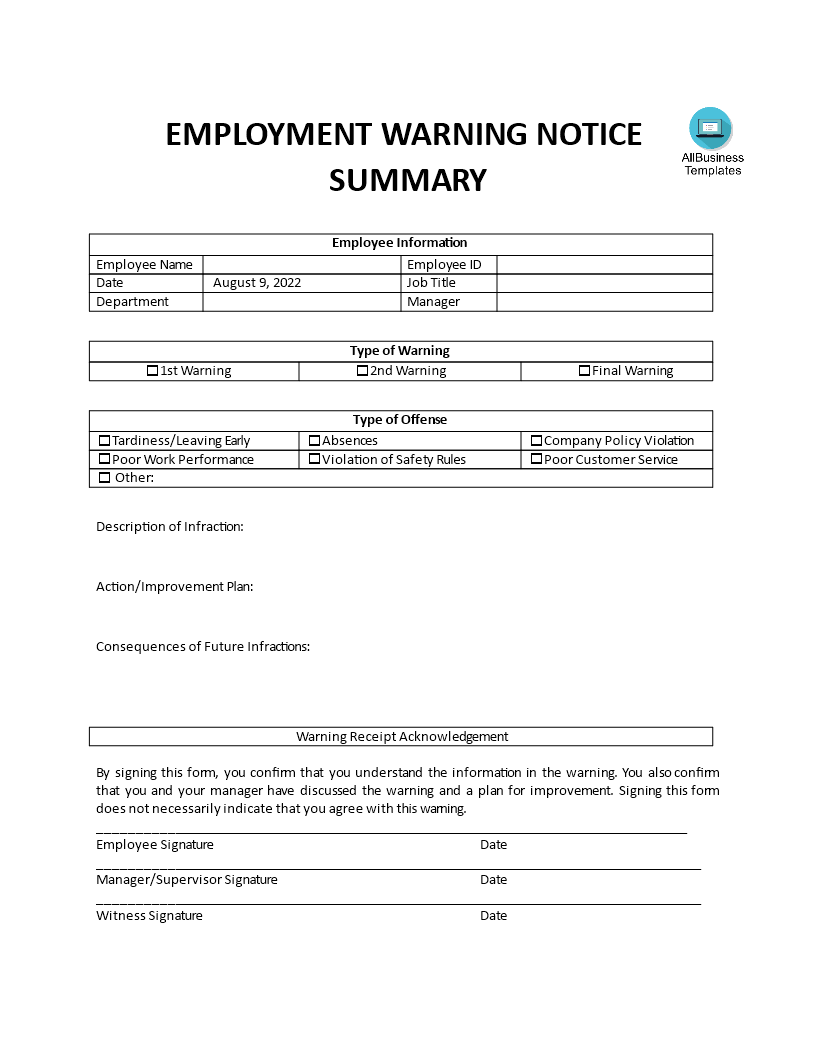Warning Form Notice Summary
Save, fill-In The Blanks, Print, Done!

Download Warning Form Notice Summary
Microsoft Word (.docx)Or select the format you want and we convert it for you for free:
- This Document Has Been Certified by a Professional
- 100% customizable
- This is a digital download (24.39 kB)
- Language: English
- We recommend downloading this file onto your computer.
How to create a write up form to summarize the warning? Can your manager write you up without verbal warning?
When you write a formal warning to an employee that certain behavior is unacceptable in the working environment and culture, which are often already specified in the company’s code of conduct. Such notifications are a disciplinary measure that is commonly used by employers to inform their staff members that they have violated company rules and continuing to do so may lead to more serious consequences. In such a letter, an employee should mention the behavior in which the employee is being reprimanded with the relevant events and dates when the code was broken. The consequences of repeating the same mistakes will also be specified, as well as what the employee should do to improve the situation.
A warning letter has to be specific and objective, and has to written according to a specific guideline and format. It generally follows conventional standards and uses a choice of solemn language appropriate for official communications. If the complaint is serious enough, an employer may be justified in issuing a final written warning without issuing a verbal or first written warning. This might, for instance, be a significant malfeasance or performance concern. Common situations when a warning letter is issues: tardiness, late coming or excessive absence ,job abandonment, refuse to work, harassment, disrespectful behavior, etc.
Writing suggestions when you want to send out a warning letter to an employee:
- Describe the violation and keep it factual;
- Specify the time and date when the problem or mistake occurred;
- Describe the possible consequences that will result from repeated unacceptable misconduct;
- Mention the company policy, HR handbook chapter or code of conduct that the employee broke;
- Describe what the employee can do to rectify or better the situation;
- Give the warning letter as soon as possible after the incident happens;
- Talk to the employee when handing over the warning;
It provides information about employee misconduct so that employees do not misunderstand.
Employee Warning Form:
Employee Information
Employee Name
Employee ID
Date
Job Title
Department
Manager
Type of Warning
- 1st Warning
- 2nd Warning
- Final Warning
Type of Offense
- Tardiness/Leaving Early
- Absences
- Company Policy Violation
- Poor Work Performance
- Violation of Safety Rules
- Poor Customer Service
- Other:
Description of Infraction
Action/Improvement Plan
Consequences of Future Infractions
Warning Receipt Acknowledgement
By signing this form, you confirm that you understand the information in the warning. You also confirm that you and your manager have discussed the warning and a plan for improvement. Signing this form does not necessarily indicate that you agree with this warning.
Signature
I have read and understood this letter and the attached Advice of First and Final Employee Warning and have been given a copy.
Download this sample warning letter to employee now and modify it according to your preferences.
DISCLAIMER
Nothing on this site shall be considered legal advice and no attorney-client relationship is established.
Leave a Reply. If you have any questions or remarks, feel free to post them below.
Warning Letter to Employee
How to write a warning letter for employee? Download our Warning letter to employee templates here and modify according to your preferences.
Read moreRelated templates
Latest templates
Latest topics
- GDPR Compliance Templates
What do you need to become GDPR compliant? Are you looking for useful GDPR document templates to make you compliant? All these compliance documents will be available to download instantly... - Google Docs Templates
How to create documents in Google Docs? We provide Google Docs compatible template and these are the reasons why it's useful to work with Google Docs... - IT Security Standards Kit
What are IT Security Standards? Check out our collection of this newly updated IT Security Kit Standard templates, including policies, controls, processes, checklists, procedures and other documents. - Letter Format
How to format a letter? Here is a brief overview of common letter formats and templates in USA and UK and get inspirited immediately! - Google Sheets Templates
How to work with Google Sheets templates? Where to download useful Google Sheets templates? Check out our samples here.
cheese

